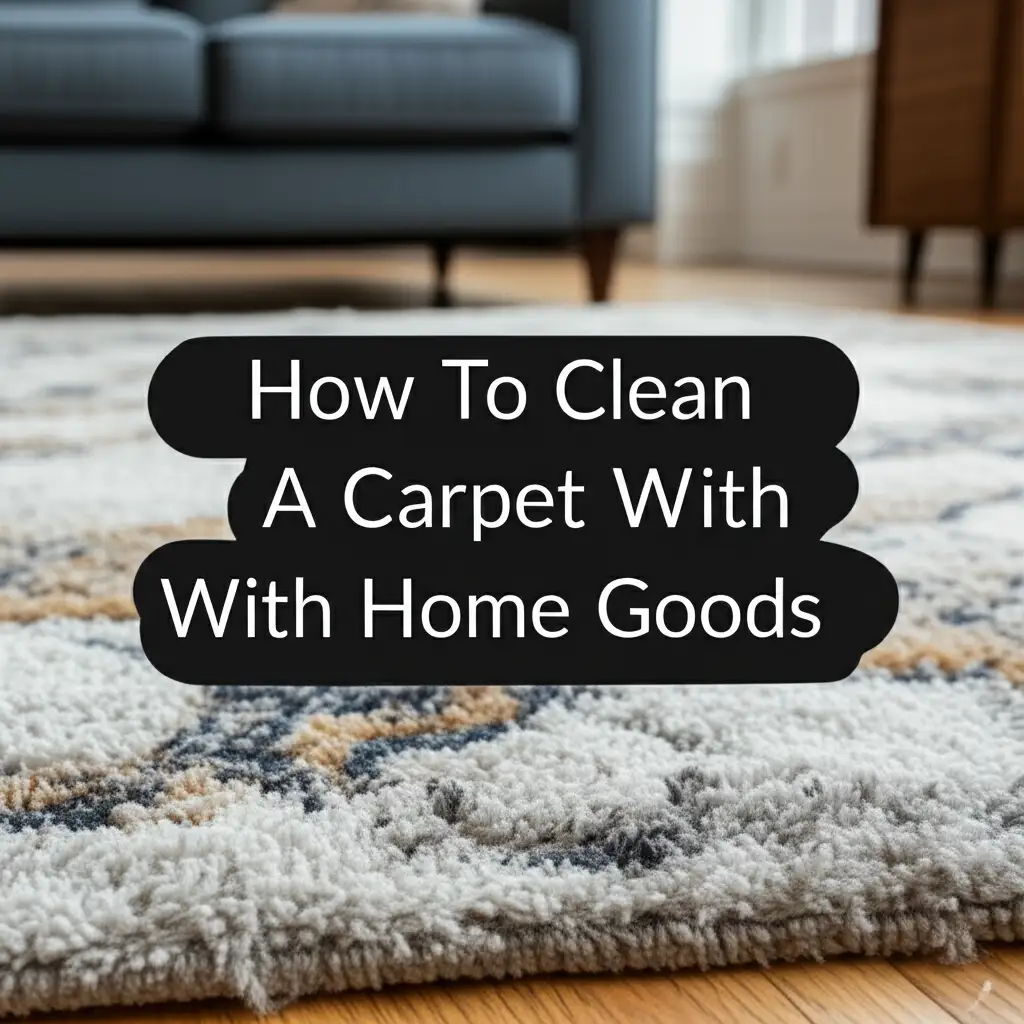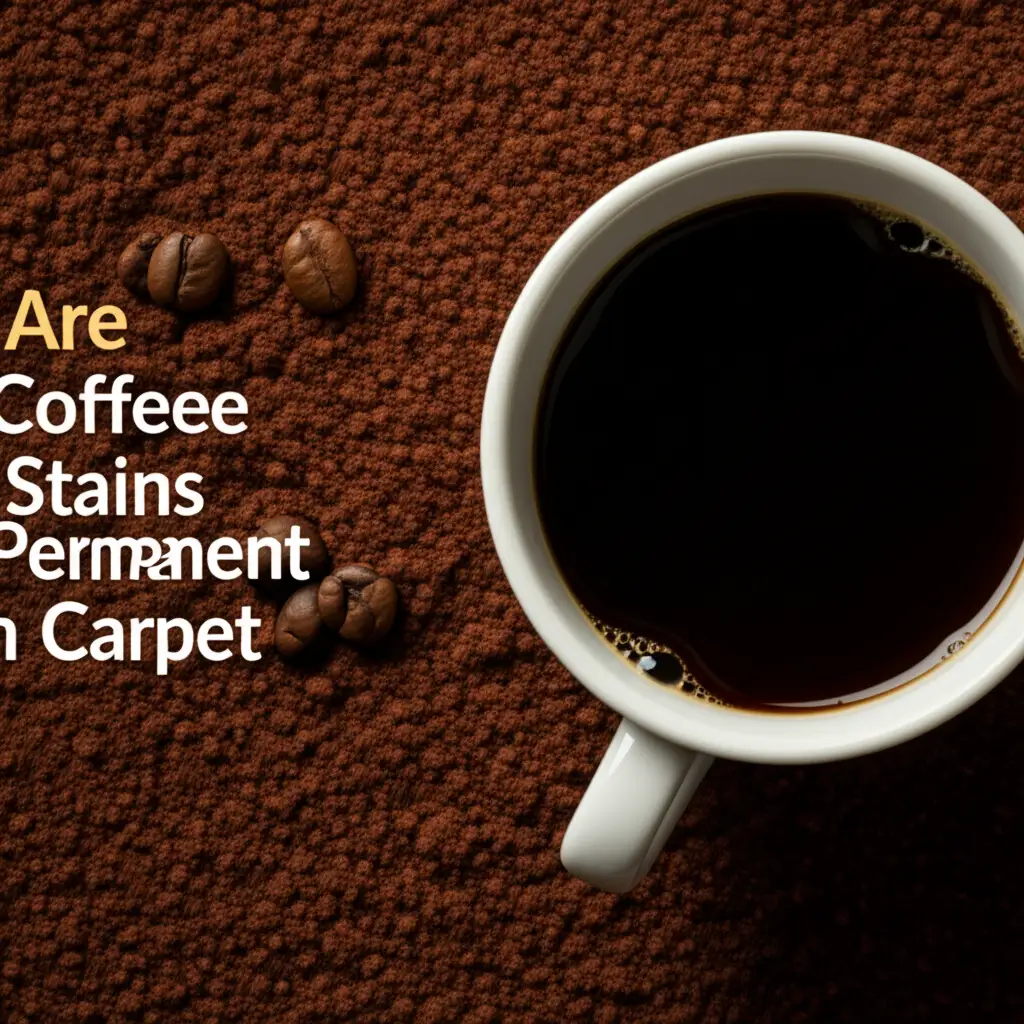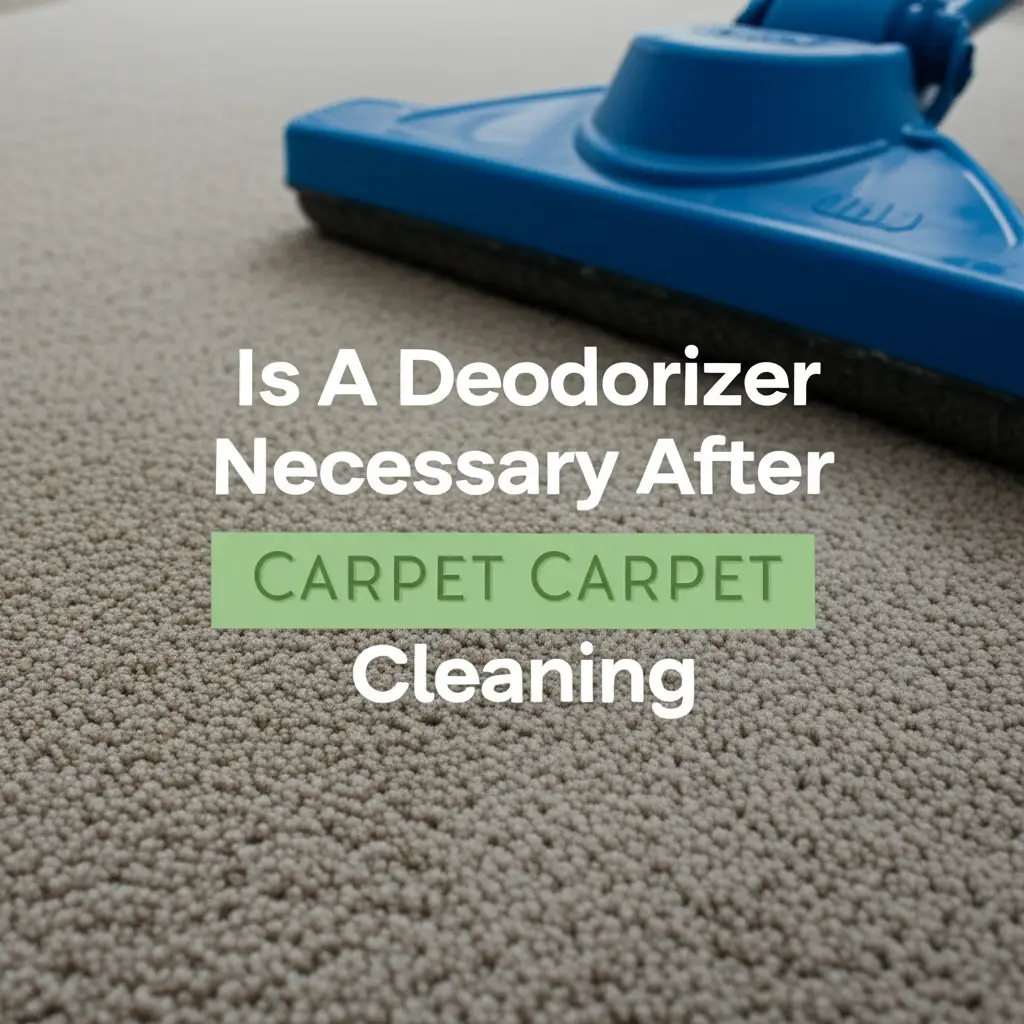· Elira Thomsen · Home Care · 17 min read
How To Clean A Carpet With Home Goods

Cleaning Your Carpet With Home Goods: A Comprehensive Guide
Dirty carpets can make any room feel less inviting. You might think you need expensive machines or harsh chemicals to get them clean. But what if I told you that effective carpet cleaning solutions often sit right in your pantry? It’s true. You can easily clean a carpet with home goods, saving money and avoiding strong chemical smells.
This guide explores practical, natural ways to tackle common carpet issues. We will look at everyday household items that work wonders on stains, odors, and general grime. You will learn how to use these items safely and effectively. We will cover spot treatments, deep cleaning methods, and tips for keeping your carpet fresh. Get ready to transform your carpet with simple ingredients you already own.
Takeaway
- Use common household items for effective carpet cleaning.
- Address spills and stains quickly for best results.
- Combine baking soda, vinegar, and dish soap for many carpet issues.
- Regular maintenance extends carpet life and freshness.
Clear, Concise Answer
You can clean a carpet with home goods like baking soda, white vinegar, dish soap, and hydrogen peroxide. These items effectively tackle most stains, odors, and general dirt. Always test solutions on a small, hidden area first to ensure they are safe for your carpet type.
Understanding Your Carpet Type Before You Clean
Before you start any cleaning project, know your carpet. Different carpet materials react differently to various cleaning agents. Wool carpets need gentle care. Synthetic carpets, like nylon or polyester, are often more durable. Silk or natural fiber carpets can be very delicate.
Applying the wrong cleaner can damage your carpet fibers. It can also set stains permanently. Always identify your carpet material first. This step prevents accidental damage and ensures a successful cleaning outcome. My advice is simple: always be sure.
Test Area First
You must test any cleaning solution on a small, hidden area of your carpet. This could be a corner under a sofa or inside a closet. Apply a small amount of your chosen cleaner. Wait a few minutes. Then, check for any discoloration or damage.
If the carpet color stays true and the texture remains unchanged, the solution is safe to use. This simple test prevents big mistakes. It gives you peace of mind before you tackle a larger stain or area. I always do this myself.
Common Carpet Materials
Most carpets in homes are made from synthetic fibers. Nylon is very durable and stain-resistant. Polyester is soft and resists water-soluble stains. Olefin is moisture and mildew resistant, often used outdoors or in basements. These synthetic materials generally hold up well to home cleaning solutions like vinegar and baking soda.
Wool carpets require more care. They are natural fibers and can shrink or discolor with harsh chemicals. Always use mild solutions for wool. Silk carpets are even more delicate; professional cleaning is often best for them. Knowing your material helps you choose the right cleaning path.
Basic Home Goods for Everyday Carpet Cleaning
Many effective carpet cleaners are already in your kitchen or laundry room. These items are affordable and readily available. They also offer a natural alternative to store-bought chemicals. Using them helps you avoid harsh fumes and reduces your environmental impact.
These simple ingredients can handle a surprising range of carpet problems. They lift dirt, neutralize odors, and break down many common stains. You do not need a lot of fancy equipment to get good results. Just a few basics will do the trick.
Baking Soda for Odor and Light Stains
Baking soda is a miracle worker for carpets. It is a natural deodorizer and a mild abrasive. It absorbs odors beautifully. Sprinkle a generous amount over the carpet. Let it sit for several hours, or even overnight. The longer it sits, the more odors it absorbs.
Afterward, vacuum up the baking soda thoroughly. Your carpet will smell fresher. For light stains, mix baking soda with a little water to form a paste. Apply the paste to the stain. Let it dry. Then, vacuum or brush it away. This simple method works wonders. If you have pets, baking soda is fantastic for neutralizing pet odors. You can read more about how to freshen carpet in a home with a dog.
White Vinegar for Stains and Disinfecting
White vinegar is an excellent all-purpose cleaner. Its acidity helps break down dirt and stains. It also has natural disinfecting properties. Mix equal parts white vinegar and water in a spray bottle. Spray the solution directly onto the stain. Let it sit for 5-10 minutes.
Blot the area with a clean cloth. Do not rub, as rubbing can spread the stain. Repeat until the stain lifts. The vinegar smell disappears as it dries. This solution is particularly effective for removing many common spills. Vinegar and ammonia can also clean carpets. You can explore how ammonia and white vinegar clean carpet for more cleaning power.
Dish Soap for Greasy Stains
Dish soap is designed to cut through grease and oil. This makes it perfect for many stubborn carpet stains. Mix a few drops of mild dish soap with warm water. Create a soapy solution. Apply a small amount of this solution to a clean cloth.
Gently blot the greasy stain. Continue blotting with the soapy cloth. Then, use a separate damp cloth to rinse the area. Finish by blotting dry. This method is surprisingly effective on food spills and oily marks. Make sure to use a clear dish soap to avoid adding color to your carpet.
Tackling Specific Stains with Household Solutions
Different stains require different approaches. Knowing which home good works best for a particular stain makes cleaning easier. Acting quickly is always key. Fresh stains are much easier to remove than old, dried-in ones. Always have your basic cleaning supplies ready.
I have found that quick action saves a lot of headaches. Do not let spills sit. Address them right away. This proactive approach prevents stains from setting deeply into the carpet fibers. It also makes subsequent cleaning simpler and more effective.
Pet Stains and Odors
Pet accidents are common carpet challenges. They leave both a stain and an odor. First, blot up as much of the liquid as possible. Use a clean, absorbent cloth. Press firmly to soak up the urine. Rinse the area lightly with clean water. Blot again.
Then, apply a solution of equal parts white vinegar and water. This neutralizes the odor. Sprinkle baking soda over the area. Let it sit overnight. The baking soda will absorb remaining odors and moisture. Vacuum it up the next day. This method works well for both fresh and older pet stains. Learn more about how to clean carpet stains pets.
Coffee and Tea Stains
Coffee and tea stains can be stubborn due to their dyes. As soon as a spill happens, blot it immediately. Do not rub. Rubbing pushes the liquid deeper into the carpet. Mix one tablespoon of white vinegar with one tablespoon of dish soap and two cups of warm water.
Apply this solution to the stain with a clean cloth. Blot gently. Rinse with a damp cloth. Continue blotting and rinsing until the stain is gone. For particularly tough stains, a small amount of hydrogen peroxide can be used on light-colored carpets. Test it first to avoid bleaching.
Red Wine Stains
Red wine spills can seem terrifying. Act fast. First, blot the spill with a clean cloth or paper towel. Apply a small amount of white wine or club soda to the stain. This helps to neutralize the red pigment. Blot again.
Next, sprinkle a generous amount of salt over the entire stain. The salt will absorb the wine. Let it sit for several minutes, or even an hour. Then, vacuum up the salt. Finish with a solution of dish soap and water if any residue remains. This multi-step process effectively tackles red wine. For specific food stains like cheese, you can find more guidance on how to clean cheese out of carpet.
Oil and Grease Stains
Oil and grease stains require an absorbent approach. First, scrape off any excess oil with a dull knife or spoon. Do this gently. Then, sprinkle a generous amount of cornstarch or baking soda over the stain. These powders will absorb the oil.
Let the powder sit for at least 30 minutes, or longer for older stains. The powder will clump as it absorbs the oil. Vacuum up the powder. If a mark remains, follow up with a solution of dish soap and water. Blot until clean. This method pulls the oil out of the carpet fibers.
Deep Cleaning Your Carpet with Natural Methods
Even with regular spot treatments, carpets need a deeper clean periodically. This removes embedded dirt, dust mites, and allergens. You can achieve a satisfying deep clean using common home goods. This process revives your carpet’s appearance and makes your home feel fresher.
Deep cleaning does not have to be a big, expensive chore. With the right natural ingredients and a little effort, your carpet can look and feel renewed. I find this process very rewarding. It is amazing how much dirt hides deep down.
The Baking Soda and Vinegar Method
This is a classic and effective deep-cleaning method. Start by vacuuming your entire carpet thoroughly. This removes loose dirt. Next, lightly sprinkle baking soda over the whole carpet area you want to clean. Let it sit for at least 15-30 minutes, or longer for heavy odors.
Then, mix equal parts white vinegar and warm water in a spray bottle. Lightly mist the baking soda-covered carpet with this solution. You will see a fizzing reaction. This reaction helps lift dirt. Let it sit for another 10-15 minutes. Blot the area with a clean, damp cloth. Allow the carpet to dry completely, then vacuum again. This method helps to clean machine-made carpets too. You can learn more about how to clean a machine made carpet cleaning.
Using Hydrogen Peroxide (for light carpets only)
Hydrogen peroxide is a mild bleaching agent and disinfectant. It works well on light-colored carpets for tough stains or sanitizing. Always test it in an inconspicuous area first. Mix one part hydrogen peroxide (3%) with two parts water. Apply directly to the stain using a clean cloth.
Blot the stain gently. Do not oversaturate the carpet. Let it sit for a few minutes. Then, blot with a clean, damp cloth to rinse. This method can be powerful for removing old stains. It also helps disinfect the carpet surface. Be very careful with colored carpets, as it may cause fading.
Steam Cleaning with Vinegar (DIY Style)
While dedicated steam cleaners are best, you can mimic some effects. Boil water and pour it into a spray bottle. Add a cup of white vinegar. Mist the carpet lightly with the hot vinegar solution. The steam helps loosen dirt.
Immediately blot the area with clean, absorbent towels. You can also place a damp towel over the area and iron it briefly on a low setting. This creates localized steam. Be careful not to hold the iron in one spot too long. This method is more for spot deep cleaning than whole rooms. It is a way to get some of the benefits of steaming your carpet. You can learn more about whether steaming a carpet cleans it.
Specific Carpet Cleaning Situations
Some carpet cleaning needs are more specialized. Whether it is a certain room or a type of carpet construction, specific considerations apply. Understanding these nuances helps you choose the most effective and safest cleaning methods. This ensures your efforts are not wasted.
Different carpets experience different types of wear and tear. A bathroom carpet, for instance, faces unique challenges compared to a living room rug. Knowing these differences helps tailor your cleaning approach. I always think about the specific use of each carpet.
Cleaning Bathroom Carpets
Bathroom carpets often face humidity, soap scum, and mildew risks. Regular cleaning is crucial for these areas. First, shake out any loose debris outdoors. Vacuum the carpet thoroughly. For general cleaning, a solution of white vinegar and water works well.
Spray the solution over the carpet. Let it sit for 10-15 minutes. Then, blot the area with clean towels. For mildew or mold, use a diluted hydrogen peroxide solution (one part peroxide to two parts water). Test first. Allow the carpet to dry completely in a well-ventilated area. This prevents new mildew growth. You can learn more about how to clean a bathroom carpet.
Carpets Without Padding
Carpets without padding, like some throw rugs or older installations, might be more prone to moisture damage. Water can soak through to the subfloor easily. When cleaning these carpets, avoid oversaturation. Use less liquid.
Apply cleaning solutions sparingly. Blot more vigorously to remove moisture. Air dry thoroughly. You might even lift the carpet to dry the subfloor underneath if it gets too wet. A dry vacuum is important for these carpets. You can read more about how to clean carpet that has no padding underneath it.
Considerations for Dry Cleaning vs. Wet Cleaning
Some carpets are labeled “dry clean only.” This usually applies to delicate materials like silk or certain natural fibers. For these, using home goods with water is risky. Wet cleaning can cause shrinkage, discoloration, or damage.
For most common household carpets, wet cleaning with home goods is fine. But for specialty carpets, consider professional dry cleaning. If you are unsure, always consult a professional carpet cleaner. Or do a very small, hidden spot test. This helps avoid irreversible damage. You can explore whether you can dry clean a carpet for more information.
Advanced Tips and Maintenance for Carpet Longevity
Cleaning is not just about removing stains. It is also about preserving your carpet’s life and appearance. Regular maintenance and a few advanced tips can keep your carpet looking fresh for years. This also reduces the frequency of deep cleaning.
Think of carpet care as ongoing attention, not just a one-time fix. Small efforts regularly make a big difference. This approach saves time and money in the long run. I always tell people that prevention is the best cleaning method.
Regular Vacuuming is Key
Frequent vacuuming is the most important step in carpet maintenance. It removes loose dirt and dust before they get embedded in the fibers. Aim to vacuum high-traffic areas at least twice a week. Vacuum less-used areas weekly. Use a vacuum with strong suction.
Adjust your vacuum cleaner to the correct height for your carpet pile. This ensures effective dirt removal without damaging the fibers. Regular vacuuming prevents buildup. It makes spot cleaning more effective when spills happen. This simple habit keeps your carpet looking good.
Addressing Stubborn Stains and Residue
Sometimes, a stain might not fully disappear with one treatment. Or a sticky residue might remain. For stubborn stains, repeat the cleaning process. You might need to let the solution sit longer. Gently agitate the area with a soft brush.
For residue, rinse the area thoroughly with clean water. Blot until no more suds appear. A slightly damp cloth can help pick up any sticky film. Ensure the area dries completely to prevent mildew. Persistent effort often pays off with tough spots. For machine owners, knowing how to clean out powerscrub carpet cleaner ensures your equipment is ready.
Protecting Your Carpet from Future Stains
Prevention is always better than cure. Use doormats at all entrances. This stops dirt from entering your home. Ask family members and guests to remove shoes indoors. This drastically reduces tracked-in grime. Consider using area rugs in high-traffic zones.
These rugs can be cleaned more easily or replaced. Apply a carpet protector product if your carpet does not have one. These protectors create a barrier against spills. They make future cleaning much simpler. Taking these steps extends your carpet’s clean life.
Refreshing Your Carpet Naturally
Between deep cleans, you can keep your carpet smelling fresh. Sprinkle baking soda over the entire carpet. Let it sit for a few hours. Vacuum it up. For an added boost, mix a few drops of essential oil (like lavender or tea tree) with the baking soda before sprinkling.
This gives a pleasant, natural scent. You can also mist the carpet lightly with a diluted white vinegar solution. This neutralizes lingering odors. Regular refreshing keeps your home smelling clean and inviting. It also helps manage odors from pets or cooking.
When to Call a Professional
While home goods are incredibly effective for most carpet issues, some situations call for professional help. Recognizing these moments can save your carpet. It also ensures the best possible outcome for very specific problems. Do not hesitate to seek expert advice when needed.
Sometimes, a stain is too big or too old. Or the carpet material is too delicate for DIY attempts. Professionals have specialized equipment and knowledge. They can handle what home methods cannot. This is an important part of comprehensive carpet care.
Large or Old Stains
Very large spills, especially if they are old and dried, can be difficult. Deeply embedded stains might require professional-grade equipment. These machines extract dirt and grime from deep within the carpet pile. Home methods might only clean the surface.
Attempting to clean very large or old stains yourself could spread them. It could also damage the carpet fibers. Professionals have stronger solutions and more powerful suction. They can often revive carpets that seem beyond hope.
Delicate Carpet Materials
As mentioned, some carpet materials are too delicate for water-based cleaning. Silk, jute, or certain antique rugs fall into this category. Using a home cleaning solution on them can cause irreversible damage. They might shrink, discolor, or fray.
Professional cleaners understand these materials. They use specialized dry-cleaning methods or very gentle techniques. If you are unsure about your carpet type, a professional assessment is wise. It protects your investment.
Mold or Mildew Infestations
If your carpet has extensive mold or mildew growth, especially after water damage, professional intervention is necessary. Mold can spread quickly. It poses health risks. Simple home remedies might not kill all the mold spores.
Professionals have the right products and drying equipment. They can safely remove mold and prevent its return. They also address the underlying moisture issue. This protects both your carpet and your indoor air quality.
FAQ Section
How often should I clean my carpet using home goods?
You can spot clean stains immediately as they happen. For general refreshing, sprinkle baking soda every few weeks. Deep cleaning with home goods, like the baking soda and vinegar method, can be done every 3-6 months. This schedule helps maintain freshness and cleanliness.
Can home goods truly deep clean a carpet like a machine?
Home goods can provide a surprisingly effective deep clean for light to moderate dirt. They lift surface dirt and neutralize odors. However, they might not extract deeply embedded soil as thoroughly as a powerful carpet cleaning machine. They are excellent for maintenance and minor refreshes.
Are home goods safe for all carpet types?
Most home goods like baking soda and white vinegar are safe for common synthetic carpets (nylon, polyester). Always test on an inconspicuous area first. Delicate materials like wool, silk, or natural fibers may require professional cleaning. Hydrogen peroxide is usually only safe for light-colored carpets.
What should I do if a home good cleaning makes my carpet look worse?
If a home good cleaning makes your carpet look worse, stop immediately. Rinse the area with plain water and blot thoroughly. Allow the carpet to dry completely. If discoloration or damage persists, consult a professional carpet cleaner. They can assess the damage and suggest corrective actions.
Can I mix different home cleaning agents for better results?
It is generally best not to mix different home cleaning agents without specific instructions. For example, mixing vinegar and hydrogen peroxide can create a dangerous chemical reaction. Stick to proven single-ingredient or simple two-ingredient solutions like baking soda and vinegar. Mixing agents can sometimes cause unexpected reactions or damage.
How long does it take for a carpet to dry after cleaning with home goods?
Drying time depends on how much liquid you used and room ventilation. A lightly damp spot can dry in a few hours. A more thoroughly cleaned area might take 12-24 hours. Increase airflow by opening windows or using fans. Ensure the carpet is completely dry to prevent mildew.
Conclusion
Cleaning your carpet with home goods is a practical, eco-friendly, and cost-effective way to maintain a fresh home. You have learned that everyday items like baking soda, white vinegar, and dish soap are powerful allies. These simple remedies can tackle a wide range of stains, odors, and general grime. Regular maintenance, quick action on spills, and understanding your carpet type are vital steps.
Embrace these natural cleaning methods to keep your living spaces inviting and healthy. You can achieve fantastic results without harsh chemicals or expensive equipment. This approach empowers you to maintain a cleaner, greener home environment. Start transforming your carpets today using the simple home goods you already have. Your carpet and your wallet will thank you.
- carpet cleaning
- home remedies
- DIY cleaning
- natural cleaning
- stain removal
- eco-friendly cleaning
- odor removal





